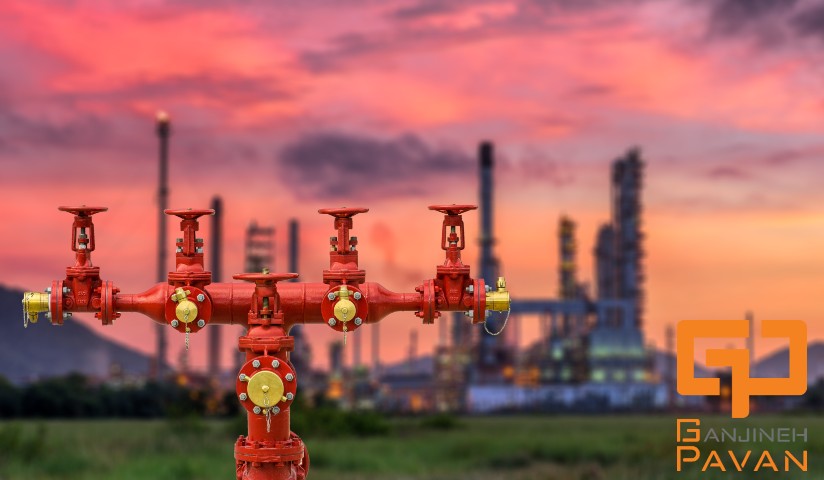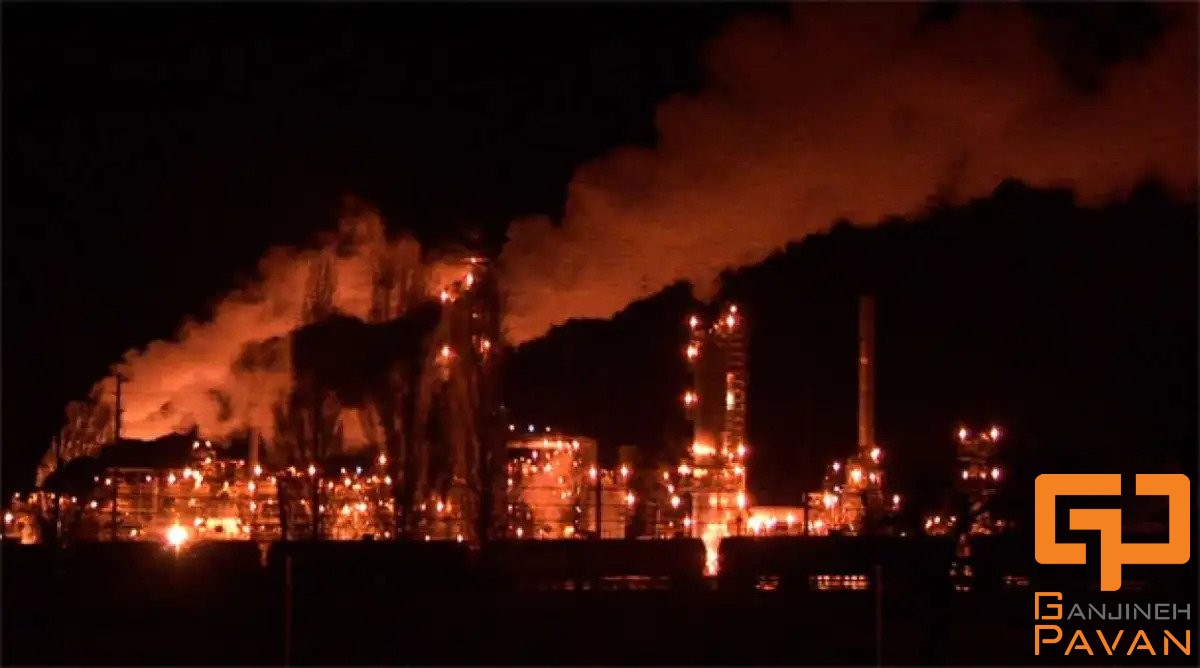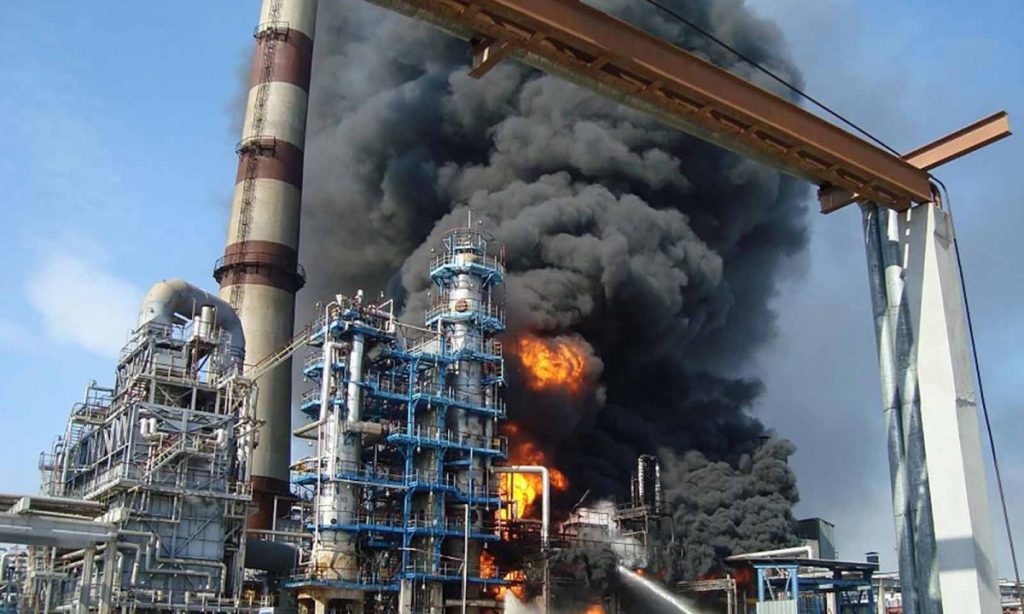Firefighting strategies and tactics are most Petroleum refineries hazards industries due to their characteristic of handling, processing and storing different types flammables materials at or above flash point and ignition temperature. There are number of hazards including flammability, toxicity, explosion, physical hazard, noise, ergonomics, electrical hazard, etc.
Amongst all the type of hazards, fire, explosion and toxicity hazard are the major concerns in the petroleum refineries. Petroleum refineries fire and explosion can cause massive damage to company installations, loss of life and health hazards to the neighborhood.
Although there are many different hazards in oil refineries but this article provides a detail knowledge on firefighting strategy and tactics for fighting refinery process unit fire, heat exchanger fire, heater fire, furnace fire, vent fire, sewer fire, oil terminal/gantry fire, oil tanker fire, storage tank fire, LPG fire, Natural gas fire, etc
Gas like hydrogen is highly flammable, only 0.019 mJ ignition energy required to fire or explosion. All the hydrocarbon vapors are heavier than air and forms vapour cloud, during leak may cause explosion after getting ignition. As per Lewis and von Elbe, minimum ignition energy required to ignite vapours of hydrocarbon like butane, propane, motor spirit (gasoline) and gases like methane and ethane is about 0.1 mJ.
There are explosion hazards in exchanges, reactors, furnace, columns and vessels due to high temperature and pressure.
During refinery maintenance or catalyst replacement work, there is always risk of pyrophoric fire.
In addition, when the liquid converted to gas, it expands and creates more pressure inside the container, for example, expansion ratio of Boiling Liquid Expanding Vapour Explosion (BLEVE): LPG from liquid phase to vapour phase is 1: 270 (i.e. 1 liter of liquid expands to 270 liters of vapour/gas).
Three main factors responsible for BLEVE, one is the over pressurization due to the boiling of liquid, the second vaporization rate is more than venting and the third is material loose it’s tensile strain due to prolong heating by an external flame.
UVCE occurred when flammable gas released into the atmosphere, after some delay, forms a vapour cloud and ignited by ignition source away from its point of leak source resulted into deflagration.
In UVCE, the flame propagate at an ultrasonic velocity thus produces shock waves and destroys the entire installation covered under the cloud.
A secondary fire in the facility can be caused by shock wave and direct contact of fire and explosion.
If the gas is heavier than air (LPG, vapours of gasoline, diesel, kerosene and other hydrocarbons), the flammable cloud covers more area whereas lighter gas (hydrogen, methane, etc) forms less flammable cloud.
At initial stage of oil storage tank firefighting operation, when foam encounters hot surface of the burning oil, a sudden expansion of the oil occurs, increases the volume and begins to overflow, this phenomenon is called as slope over.

Fire safety in refinery and petrochemical industries
National and international standards are available for refinery and petrochemical fire safety systems which provides the detail guideline on designing and installation of complex. Modern technology provides the PLC base safety systems including various interlocks, blow down system, venting systems, etc.
Typically, passive fire safety system is for prevention and active fire safety system is for protection.
Refinery fire protection system
Refinery fire protection system is broadly divided into two category, passive and active.
is broadly divided into four categories and can be used to control the fire, extinguish the fire, and/ or provide exposure protection to prevent domino effects. Active Active fire protection system firefighting system in oil and gas industry is maintained by dedicated company fire department.
It includes portable fire extinguishers, fire buckets, hose reel, foam trolley, etc. Adequacy and placement can be done with reference of 1. Portable firefighting equipment: NFPA-10.
- Fixed fire protection systems : here are the fixed fire protection systems widely used in refinery and petrochemical industries.
2.1 Water based fixed fire protection system : It includes, Fire water pumps with fire hydrants and fire monitors, medium velocity water spray system (MVWS).
2.2 Clean gas fire protection fixed system: It can be total flooding type or/and local application system type. These systems are suitable for protecting control rooms, satellite buildings, generator rooms, battery rooms, cable cellars, etc.
2.5 Rim seal fire protection system : It is a fixed type automatic fire protection system intended to protect the rim seal area of the floating roof tank, the detection ring and the foam pouring nozzles are placed between the primary and secondary seal of the floating roof and foam modules are mounted on the roof.
Without isolating the source or cutting off the fuel supply, it is very difficult to extinguish refinery process unit fires. Starvation (elimination of fuel) is the best technique to fightprocess unit fires.
Machinery on fire must be switched off and start the standby machine, if possible. Apply carbon-dioxide or DCP to extinguish the fire. Do not use water or fire fighting foam as it may cause electrocution. De-energise the circuit, if possible.
Water sprays can be used to protect the structural members outside the fire box threatened by flame. As the firefighting foam is ineffective, do not use it.
Avoid overflowing trenches or pits with water since this may cause spread of fire. Don’t allow any person to work near fire traps.

Fighting sewer fires in refinery is challenging as there is always a risk of explosion. This type of fire can affect many process units as they may be connected internally though sewer. During the explosion, covers of the sewer manholes can blow out and damage the neighbouring facility.
Many vessels and equipment in refinery are mounted aboveground on steel structure platform. The underneath of these equipment, there may also be other equipment handling flammable materials.
If an oil leak forms pool at above ground level in oil catch pit area or forms pool at ground level, then firefighting foam must be used to extinguish the fire. Keep in mind that foam is ineffective on 3D fire. If there is pool fire or surface fire, foam may be applied.
More details on full surface large diameter tank firefighting strategies, you may read below article
The best method is controlled burning of leaking LPG as it prevents the formation of vapour cloud. The application of sufficient quantity of water to keep the shell of the vessel and piping cool will allow the fire to consume the products without risk of causing failure. It is desirable that the leaks cannot be controlled after extinguishing fire and wherever the leak can be controlled, attempt to extinguish the fire.
Hydrogen is extremely flammable and ignites with very less energy (0.02 micro joule). The hydrogen fire turnout should be accompanied by DCP tender/ engine. The fire tender/engine must be parked in the upwind direction and firefighting operation must be initiated from upwind /cross wind.
If the gas is already burning , it can be dangerous to extinguish the flame and allow the gas to flow and burn , otherwise an explosive mixture may form with air which , if ignited , can cause considerable damage more important than if the original fire had been allowed to burn . The best method to extinguish a gas fire is to stop the gas flow.
inherently possess high risk of fire and explosion due to processing and storing highly flammable material. In this article we have discussed various Oil refinery and Petroleum industries firefighting method, strategies and tactics to manage the fire and explosion hazards to save the life and property.Process fires can be extinguished effectively by ensuring adequate and effective firefighting strategies and techniques, but the major control is to isolate the fuel supply. Crude oil storage tank fire is challenging as possess boil over hazard and required effective firefighting strategy with numerous resources. Exchanger fires possess explosion hazard and application of water may lead to thermal shock therefore DCP/steam are the best firefighting media to extinguish the fire. Flammable gas fire should not be attempted to extinguish as it may cause vapour cloud and increase risk of vapour clod explosion.







